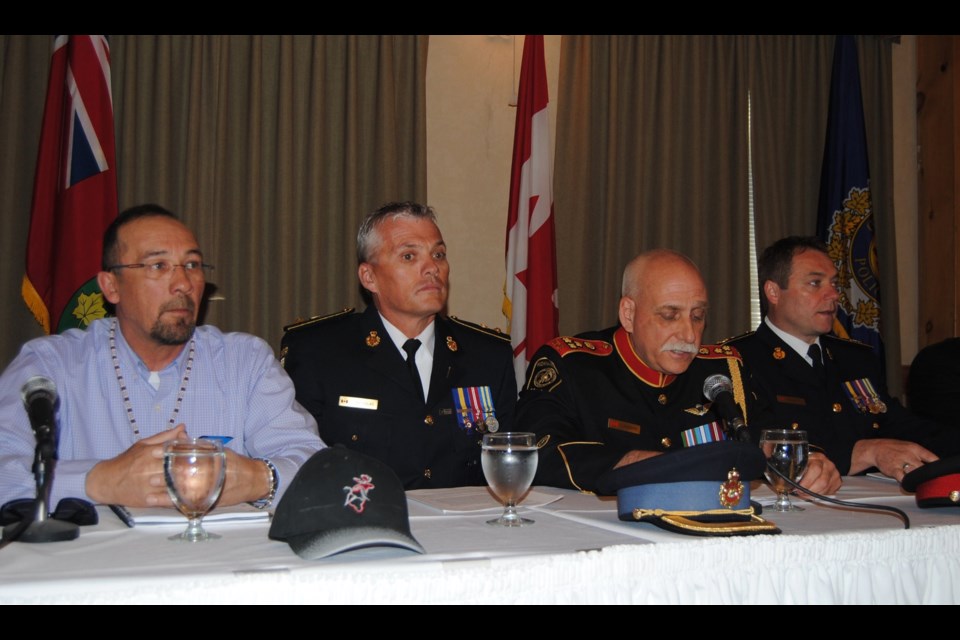Project Coast, a coordinated action between the Nishnawbe Aki Police, Ontario Provincial Police, Timmins and Ottawa Police seized large quantities of mainly prescription drugs, leading to 52 arrests.
Despite the success of that operation, keeping dangerous drugs out of First Nations remains an ongoing concern said the commanding officers who oversaw the successful operation.
“The magnitude of the charges and the quantities of drugs seized through this operation,” said Chief Terry Armstrong of NAPS, “gives a clear picture as to what is happening to our communities.”
The task of preventing drugs from being transported over a large geographic area described by one of the police spokesperson as being the size of France poses challenges.
“The amount of drugs we seized was shocking,” Armstrong continued. “And yet you should know that NAPS is not funded by the province.”
Even though there are very few ways of getting to the more remote First Nations – either by plane or barge for materials and via the winter road during the winter.
“We have limited resources as far as the winter road is concerned but we did step up to a level that we could,” said Chief Armstrong.
He noted that some bands do their own airport checks and pay from their own band funds.
“If we have intelligence that stuff is coming in through the airports we are there,” Chief Armstrong said.
However, Armstrong explained that the method of conveying drugs to First Nation communities is ever changing and sometimes the best way to stop the supply is to cut it off at its source which was the aim of Project Coast.
“Sometimes it is easier to get at the source as it is to get it as it moves around,” Chief Armstrong noted.
“We also have done some work with Canada post to make some significant seizures,” Armstrong added. “Not in this case but others. it was called Project Nexus.
OPP commander Barnum explained the today’s drug traffickers have reduced the supply of bulkier drugs such as marijuana in favour of smaller harder to detect drugs.
“I think it is important to note that pills are very small and hard to detect,” interjected Deputy OPP Commissioner Barnum. “Sometimes even during searches these small pills can be missed.”
“We have those pills amassed in big bags on the table, but that isn’t how they are trafficked into the communities,” Barnum noted.
“A fentanyl patch is pretty easy to conceal,” Barnum added. “It is really tough do this kind of investigation.
Barnum said there was no one way to stop drug smuggling into First Nations but that a coordinated approach would produced the greatest success.
“Security at the airport and enforcement on the winter road are key and so are enforcements like Project Coast,” he said.
“As well as drug education in the community is important,” he added.
The ever changing methods of conveying drugs is also problematic, Barnum noted.
“We have to constantly keep up with the changes in how the dealers,” Barnum added.
Grand Chief Jonathon Solomon of the Mushkegowuk Council which represents the four First Nations along the James Bay Coast said that communities take money out of their budget to help catch drug smugglers by checking luggage from incoming flights.
He noted that takes money from other desperately needed services.
“It’s a case of damned if you do and damned if you don’t” Grand Chief Solomon said.
Former Chief of Attawapiskat First Nation Theresa Hall said her First Nation spent money on airport checks.
“But even that can’t stem the flow,” she said.
She applauded the success of Project Coast.
Gilles Bisson, Timmins-James Bay MPP said the province is responsible for policing on First Nations.
“Policing on the reserve falls under the Ontario Police Services Act,” Bisson said. “Enforcing the criminal code is the federal part.”
“Enforcement on reserve is complicated by the lack of resources and other factors make it difficult for the police to do their jobs,” Bisson added.
“This action by NAPS, the OPP, Timmins and Ottawa Police is well welcomed by people on the coast and might be the beginning of more such actions,” Bisson said.
In his opening remarks Chief Terry Armstrong called on Ontario to make NAPS a full police force funded by the province. Currently it is funded instead under an agreement with the federal government which is set to expire in 2018.
“All it would take,” Chief Armstrong said, “is new legislation making NAPS an official Ontario police force.”
The alternative would be a regulation under Ontario Police Services Act – an act which the Wynne government is committed to reviewing and improving.



